
Heidelberg is a city in the German state of Baden-Württemberg, situated on the river Neckar in south-west Germany. As of the 2016 census, its population was 159,914, of which roughly a quarter consisted of students.

The Harderbahn (HB) is one of two funiculars that operate from the town of Interlaken. The Harderbahn leads to the western end of the Harder in the north of Interlaken across the river Aare, in Switzerland.

The Dresden Suspension Railway is a suspended funicular located in Dresden, Germany, and connects the districts of Loschwitz and Oberloschwitz. It is one of the oldest suspension railways, having entered service on 6 May 1901, the same year the Wuppertal Schwebebahn entered service. Like the Wuppertal railway, this system was designed by Eugen Langen. The line is 274 metres (899 ft) long and is supported on 33 pillars.
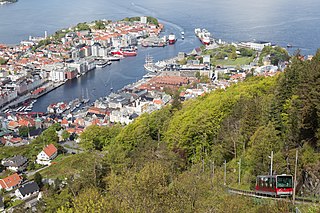
The Fløibanen is a funicular railway in the Norwegian city of Bergen. It connects the city centre with the mountain of Fløyen, with its mountain walks and magnificent views of the city. It is one of Bergen's major tourist attractions and one of Norway's most visited attractions. The line is 844 m (2,769 ft) long, covers a height difference of 302 m (991 ft), and carries over one million passengers a year. The line is owned by Fløibanen AS, a company with a number of shareholders, the biggest being the municipality of Bergen.
The Guindais Funicular is a funicular railway in the civil parish of Cedofeita, Santo Ildefonso, Sé, Miragaia, São Nicolau e Vitória, Portuguese municipality of Porto.
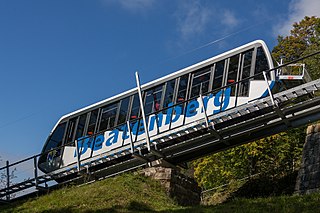
The Thunersee–Beatenberg Funicular is a funicular in the canton of Bern, Switzerland. It links a jetty, at Beatenbucht in the municipality of Sigriswil and on the shores of Lake Thun, to the village of Beatenberg, situated on the plateau above at 1,120 metres (3,675 ft) above sea level.
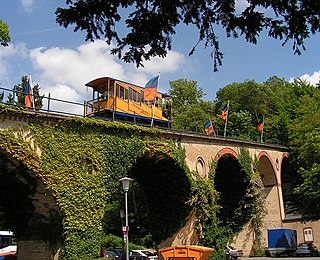
The Nerobergbahn is a funicular railway in Wiesbaden, Germany. The line links the city, with a station at the north of the Nerotalanlagen, with the Neroberg hill to its north, which offers a panorama view.
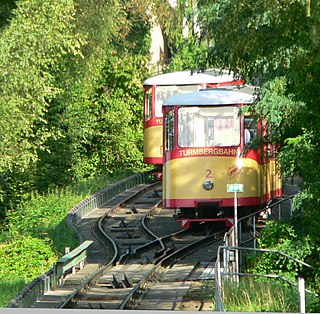
The Turmbergbahn is a funicular railway in Karlsruhe in Germany. It is the oldest operating funicular in Germany. From Karlsruhe's former center Durlach, the line climbs the Turmberg, which on a clear day provides a lookout point with views of the Rhine Valley, the Palatinate forest and the adjacent parts of Alsace.

The Sommerbergbahn is a funicular railway in Baden-Württemberg, Germany. It runs from Bad Wildbad to the top of the Wildbader Sommerberg, which gives good views over the town, with one intermediate stop.

The Königstuhl, is a 567.8 metres (1,863 ft) high hill in the Odenwald Mountains and in the city of Heidelberg, in the German state of Baden-Württemberg. The Königstuhl summit allows visitors views of the city of Heidelberg and the Neckar river. On days with good conditions the view extends to the Pfaelzerwald, which is roughly 40–50 km away.

The Santa Cova Funicular is a funicular railway at Montserrat, near Barcelona in Catalonia, Spain. The line descends from the monastery, and the upper terminus of the Montserrat Rack Railway, on a continuous curve to a lower station that gives access, via a path, to Santa Cova, a shrine lower down the mountain.

The Montjuïc Funicular is a funicular railway in the city of Barcelona, in Catalonia, Spain. The railway mainly runs through a tunnel and connects the Barcelona Metro's Paral·lel station with the hill of Montjuïc and the various sporting facilities and other attractions there.
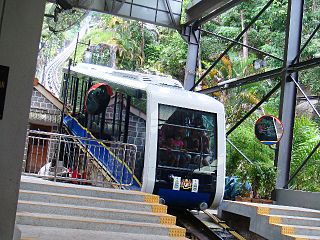
The Penang Hill Railway is a one-section funicular railway which climbs the Penang Hill from Air Itam, on the outskirts of the city of George Town in the Malaysian state of Penang. The railway first opened in 1923 as a two-section railway, but was overhauled in 2010 into a one-section system. It is a single-track railway with a passing loop, and it passes through a tunnel which is the steepest in the world. The total journey time can take between five and twenty minutes. The funicular train coach travels directly from the lower station to the top, but may stop at other intermediate stations upon request.

The Trieste–Opicina tramway is an unusual hybrid tramway and funicular railway in the city of Trieste, Italy. It links Piazza Oberdan, on the northern edge of the city centre, with the village of Villa Opicina in the hills above.

Dresdner Verkehrsbetriebe AG (DVB) is the municipal transport company of the city of Dresden in Germany. It is a member of the Verkehrsverbund Oberelbe transport association that manages a common public transport structure for Dresden and its surrounding areas. The DVB operates the Dresden tram network comprising 12 tram lines, with a total line length of approximately 210 kilometres (130.5 mi) and a total route length of 132.7 kilometres (82.5 mi), and 28 bus lines, with a total line length of approximately 306 kilometres (190.1 mi). It is also responsible for two funicular railways and three ferries across the River Elbe.

The Dolderbahn is a 1.3 km (0.81 mi) long rack railway in the Swiss city of Zürich. The line is in Zürich's Hottingen and Fluntern suburbs on the south slope of the Adlisberg mountain. The lower terminus of the line is at Römerhof, some 1.5 km (0.93 mi) from the city centre, where it connects with lines 3 and 8 of the Zürich tramway. The upper terminus at Bergstation Dolderbahn is adjacent to the Dolder Grand Hotel and the Dolder recreation area. Two intermediate stations, at Titlisstrasse and Waldhaus Dolder, are also served.

The Zugerbergbahn is a funicular railway in the southern-eastern suburbs of the Swiss city of Zug, in the canton of Zug. The line links the Zug suburb of Schönegg with the Zugerberg mountain overlooking the city and Lake Zug. The line has a length of 1280 m and a difference of elevation of 366 m.

The Rheineck–Walzenhausen mountain railway is a 1.9 kilometres (1.18 mi) long rack railway in Switzerland. It links Rheineck station, in the municipality of Rheineck and the canton of St Gallen, with the village and health resort of Walzenhausen, in the canton of Appenzell Ausserrhoden. Passenger service on the line now forms part of the St. Gallen S-Bahn, branded as the S26.

The Odesa Funicular serves the Ukrainian city of Odesa. Running alongside the Potemkin Stairs, it connects the Prymorskyi Boulevard with the Port of Odesa.

The Lugano degli Angioli funicular was a funicular railway and inclined lift in the city of Lugano in the Swiss canton of Ticino. It linked a lower terminus near the lakeside and the church of Santa Maria degli Angioli with an upper terminus adjacent to the Hotel Bristol on the Via Clemente Maraini. The line remains in existence, although in an abandoned state and with no car. For most of its length, it is paralleled by the steps of the Salita degli Angioli.























